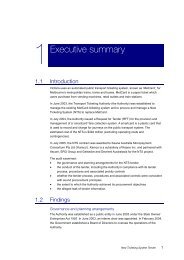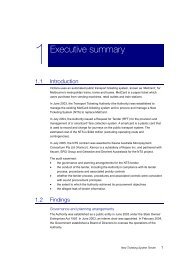Delivering HealthSmart Report - VAGO
Delivering HealthSmart Report - VAGO
Delivering HealthSmart Report - VAGO
You also want an ePaper? Increase the reach of your titles
YUMPU automatically turns print PDFs into web optimized ePapers that Google loves.
Realisation of benefits from the HealthSMART program<br />
4.3.2 Business transformation via technology upgrades<br />
Implementation of new ICT systems offers an opportunity to improve and re-engineer<br />
existing business processes, rather than merely replace obsolete systems. While the<br />
replacement of HOMER across so many agencies was a primary imperative for the<br />
initiation of the project, it was always intended that the capability within new systems<br />
would be significantly greater than that provided by the legacy system.<br />
All agencies that have implemented FMIS have removed the risk of obsolescence.<br />
Some agencies have also taken the opportunity to improve their business processes<br />
by:<br />
• standardising catalogues and improving ordering of supplies<br />
• improving management of inventory and stock<br />
• implementing facilities for electronic fund transfer.<br />
The new FMIS uses a standardised chart of accounts. This has enabled DHS to<br />
consistently report financial performance and benchmark costs across the hospital<br />
sector.<br />
The gains from these enhancements have not been quantified as DHS is yet to<br />
conduct a post-implementation review of benefits.<br />
4.3.3 Benefits yet to be realised<br />
The most significant benefits from the HealthSMART program have yet to be realised<br />
due to delays in implementing clinical systems.<br />
Clinical systems are the single, largest investment with the HealthSMART program<br />
accounting for $96 million (30 per cent) of the $323 million budget. However, after<br />
more than four years there have been no implementations of clinical systems in<br />
Victoria.<br />
Adverse events and medical error in the health care sector are an important public<br />
health problem. They contribute significantly to patient morbidity and mortality, and to<br />
the cost of health care due to over-treatment and rectification arising from misdiagnosis<br />
or incorrect prescribing or procedures.<br />
Expected outcomes of the HealthSMART clinical systems project include:<br />
• reduced medication errors<br />
• reduced pathology and radiology tests<br />
• reduced clinician administrative tasks, resulting in more time spent with patients<br />
• improvements in turnaround times for medication orders<br />
• increased use of less expensive drugs and tests<br />
• reduced delays in patient discharge from speedy availability of test results<br />
• reduction in additional bed-days associated with adverse events.<br />
<strong>Delivering</strong> HealthSMART — Victoria's whole-of-health ICT strategy 39
















